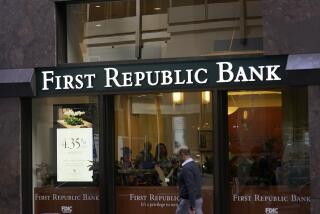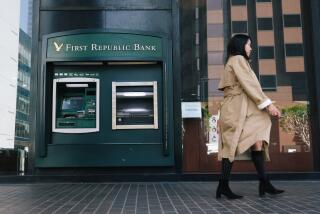Bank Board Raises Estimate of S&L; Rescue Cost to $50 Billion
- Share via
WASHINGTON — The Federal Home Loan Bank Board on Wednesday boosted its estimate for rescuing the crippled segment of the savings and loan industry to $45 billion to $50 billion and warned that healthy thrifts will have to pay a special assessment for 30 years to fund the bailout.
Under a barrage of withering questions by skeptical members of the Senate Budget Committee, bank board Chairman M. Danny Wall presented the latest in the steadily escalating cost projections for selling, merging or shutting hundreds of insolvent institutions across the country.
Wall said the bank board has devoted $20 billion so far this year to dispose of 122 sick thrifts, closing 20 and paying off their depositors, while merging or selling off the rest. The board expects to spend an estimated $24.9 billion to $29.9 billion to deal with an additional 400 insolvent thrifts, resulting in the $45-billion-plus total that Wall predicted Wednesday.
Earlier bank board estimates of the total cost were $22.7 billion in late 1987 and $30.9 billion in May.
“We can’t seem to settle for three months on the number,” complained Sen. Lawton Chiles (D-Fla.), the committee chairman.
Everyone “is engaged in a guessing game about a number,” echoed Sen. Pete V. Domenici of New Mexico, the ranking Republican. “Before we begin talking about a taxpayer bailout, we need a lot more information. We need a better understanding, and taxpayers need a better understanding.”
Wall insisted that, despite the mounting losses, the rescue can be performed with assessment funds from the healthy S&Ls; without an infusion of federal money. “There are sufficient resources,” he told the committee.
However, Wall’s plan to keep the special levy on the healthy S&Ls; for 30 years was called “outrageous,” by Mark Clark, vice president of the U.S. League of Savings Institutions, a trade association. “It’s unfair to make everybody pay--it’s not really a way to address the problem,” Clark said in an interview. He noted that the assessment burden pushed 69 thrifts into the red during the first half of this year, wiping out all their profits and leaving them with a loss.
Under the current formula, S&Ls; must pay $2.08 for every $1,000 in deposits, compared to 83 cents for banks. The fee pays for federal insurance that guarantee deposits up to $100,000.
Wall acknowledged that the high charges are an “unequal burden for the S&Ls; to carry” but argued that deposit insurance has been underpriced for years and should be reviewed by Congress. One alternative--raising the banks’ levies to the higher level--would draw a huge backlash from that industry.
‘Time Bomb’
Some outside experts, as well as a growing number of congressional leaders, are increasingly skeptical that the board will be able to manage the thrift crisis without resorting to general tax revenues.
“You have consistently underestimated the problem,” Sen. Donald W. Riegle Jr. (D-Mich.) told Wall. “Virtually every serious observer puts this in excess of $50 billion.”
The projected bailout cost keeps mounting because S&Ls; are continuing to write down the value of real estate assets battered by the economic slump in the Southwest and because buyers of sick thrifts are demanding bigger guarantees from the government.
Sen. J. James Exon (D-Neb.) called the crisis a “ticking time bomb (that) is going to blow up in our face.”
“The longer we put off action, the worse it will be. It is a cancer eating away at the base of the financial structure of the U.S.,” Exon said.
Another witness at the committee session, Herbert Sandler, chairman of World Savings of Oakland, gave the committee a blunt opinion: “The loss is there; the loans have been made, the assets wasted. The only question is how do you pay for it.”
The preferred method of dealing with insolvent S&Ls; is by mergers and acquisitions, with the bank board providing promissory notes and guarantees against losses for buyers agreeing to take over the sick thrifts. This approach avoids quickly exhausting the insurance fund’s money. If all the insolvent S&Ls; were shut down tomorrow, it would cost $109 billion to pay off depositors, bank board member Roger Martin told the committee.
However, the bank board is taking a risk in the deals, according to the General Accounting Office, the investigative arm of Congress. If the salvaged institutions continue to lose money and make bad investments, the eventual cost of bailing them out could be greater--a possibility that concerns deficit-conscious senators.
Escalating losses could deliver a blow to the federal budget and, in the process, “squeeze out all kinds of other government agencies,” Chiles said.
“That’s a heck of a way to budget, a heck of a way to appropriate,” he said. The bank board could become a “siphon” into the federal Treasury, Chiles warned.
HOW THE U.S. RESCUES THRIFTS The Federal Home Loan Bank Board says it will cost up to $50 billion to complete the rescue of more than 500 insolvent thrifts. Some 122 have been handled this year--most through mergers and acquisitions, although 20 have been simply shut down.
Healthy S&Ls; pay $2.08 for every $1,000 in deposits into a federal insurance fund. The money goes to the Federal Savings & Loan Insurance Corp., which guarantees deposits up to $100,000.
If an S&L; is shut down, regulators take money from the fund and pay off all deposit accounts up to $100,000.
Only a few S&Ls; will be closed directly. In most cases, the bank board issues notes, or IOUs, to someone who buys an S&L--guaranteeing; it will make up any losses suffered on the sale of assets. Most of the $45 billion to $50 billion will be spent to back up the notes, and to redeem the guarantees given to the buyers against losses.
When the process is finished, all the insolvent S&Ls; will have been acquired by healthy buyers or shut. Wall has not said how long it might take.
More to Read
Inside the business of entertainment
The Wide Shot brings you news, analysis and insights on everything from streaming wars to production — and what it all means for the future.
You may occasionally receive promotional content from the Los Angeles Times.










